Results
-
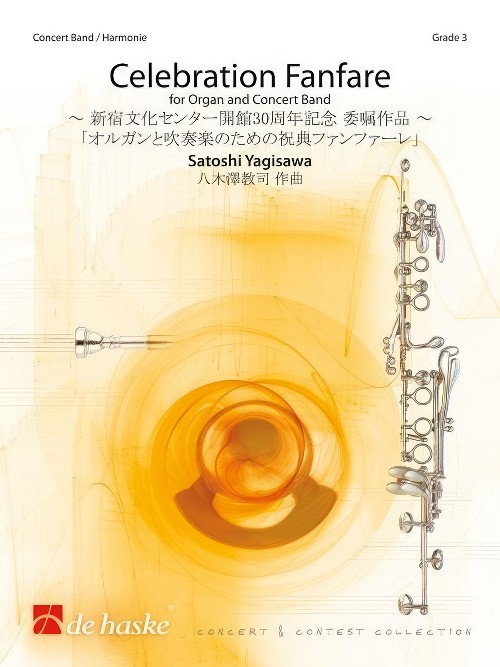 £104.99
£104.99Celebration Fanfare (Organ Solo with Concert Band - Score and Parts) - Yagisawa, Satoshi
This piece was composed in 2009 for a commission by Shinjuku Bunka Center to commemorate its thirty years since its opening.It is an impressive work with a brilliant, bright fanfare, and the stately sound of the church organ reverberating through the concert hall. The first performance was given by Hiroko Takahashi, a house organist of the centre, with Shinjuku City Wind Orchestra conducted by Shigeto Ishizu. Original works for church organ and wind orchestra are surprisingly scarce. This is a fresh opening piece, to be followed by an organ solo which might lead to a march.Duration: 5.00
Estimated dispatch 7-14 working days
-
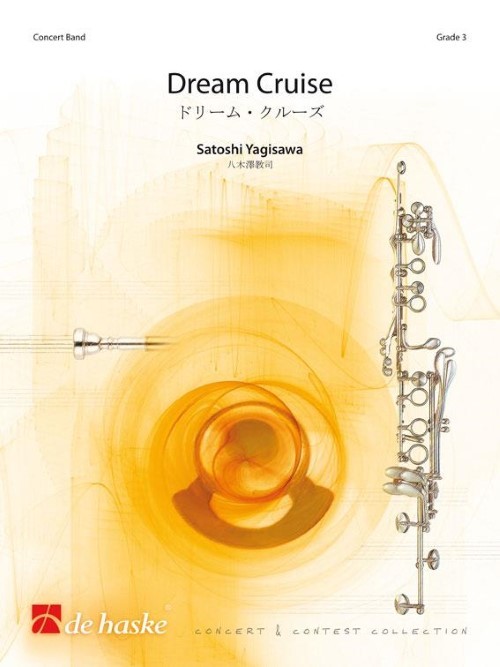 £104.99
£104.99Dream Cruise (Concert Band with Optional Choir - Score and Parts) - Yagisawa, Satoshi
Satoshi Yagisawa has lived in Ichikawa City, Chiba Prefecture in Japan since he was in elementary school. Around Christmas time every year in Ichikawa City, seven Chiba high school bands hold a joint concert. For the 20th anniversary the composer was asked to write a piece to be performed to close the concert. This piece was first performed in 2010 by Tadashi Yoshida, conductor and close friend of Satoshi Yagisawa, with a combined wind orchestra from Chiba Prefectural Kokubun High School, Chiba Prefectural Ichikawa Nishi High School, Chiba Prefectural Matsudo Mutsumi High School, Chiba Prefectural Matsudo Akiyama High School, Chiba Prefectural Matsudo Yakiri High School, Chiba Prefectural Funabashi Nishi High School and Chiba Prefectural Shiroi High School. The title was chosen from suggestions submitted by participating students. Dream Cruise was chosen by Satomi Otsu, a junior in Chiba Prefectural Matsudo Mutsumi High School Wind Orchestra. The composer skillfully scored this piece and created the chorus part so that all the hundreds of students could participate in the performance. This version has been revised so it can be played without the chorus part.Duration: 4.30
Estimated dispatch 7-14 working days
-
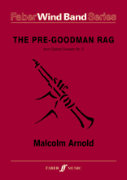 £55.00
£55.00The Pre-Goodman Rag (Clarinet Solo with Concert Band - Score and Parts) - Arnold, Malcolm - Woolfenden, Guy
Malcolm Arnold's Clarinet Concerto No. 2, Op. 115, was dedicated to Benny Goodman, and first performed by him as part of the Red Rocks Music Festival with the Denver Symphony Orchestra conducted by Brian Priestman on 17 August 1974. The third movement, known affectionately as 'The Pre-Goodman Rag', is an outrageous ragtime parody with a hauntingly wistful middle section. The work has now been made more widely available in this transcription for wind band.Duration: 2:20Recorded on QPRM137D LINDA MERRICK - CLARINET (Royal Northern College of Wind Orchestra)
Estimated dispatch 7-14 working days
-
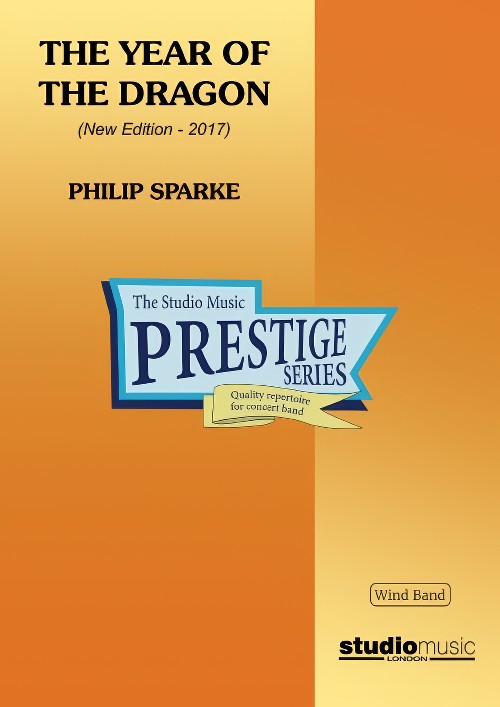 £37.95
£37.95The Year of the Dragon (Prestige Concert Band - Score only) - Sparke, Philip
The 2017 version of The Year of the Dragon was commissioned by the Siena Wind Orchestra and given its world premiere on June 17th 2017 in Bunkyo Civic Hall, Tokyo, conducted by the composer.The original wind band arrangement of The Year of the Dragon was made in 1985, a year after the composer wrote the brass band version. At that time he was still learning the intricacies of writing for wind band (and still is!) and in the 32 years which have elapsed since then, his approach to scoring for the medium has developed and, hopefully, improved.Here are the main differences between the two versions:In the 1980's, the wind band movement was much less international than it is now. British wind bands were still to some extent based on the military band tradition of the time, which tended to use rather smaller instrumentation than the then-dominant American university model. The new version embraces a much more international instrumentation, including low woodwinds and string bass, as well as an expanded percussion section.In the original version there was a touch of naivety in the way the composer wrote for the woodwinds; much of their articulation was transferred too literally from the brass version, resulting in some unidiomatic writing, which he has tried to improve in the new version.In addition to the above, Philip's own compositional style has matured and developed in the intervening 32 years. There are some passages in the original which he simply would not write today - not because they are 'wrong', but because his way of writing has changed. The new version is perhaps how he would have written it today, rather than simply dressing the original version in new clothes.The work is in three movements:Toccata opens with an arresting side drum figure and snatches of themes from various sections of the band, which try to develop until a broad and powerful theme from the middle of the band asserts itself. A central dance-like section soon gives way to the return of this theme, which subsides until faint echoes of the opening material fade to a close.Interlude takes the form of a sad and languid solo for alto saxophone. A chorale for the whole band introduces a brief spell of optimism but the saxophone solo returns to close the movement quietly.Finale is a real tour-de-force for the band with a stream of rapid semi-quavers running throughout the movement. The main theme is heroic and march-like but this is interspersed with lighter, more playful episodes. A distant fanfare to the sound of bells is introduced and this eventually returns to bring the work to a stirring close.
Estimated dispatch 7-14 working days
-
 £199.95
£199.95The Year of the Dragon (Prestige Concert Band - Score and Parts) - Sparke, Philip
The 2017 version of The Year of the Dragon was commissioned by the Siena Wind Orchestra and given its world premiere on June 17th 2017 in Bunkyo Civic Hall, Tokyo, conducted by the composer.The original wind band arrangement of The Year of the Dragon was made in 1985, a year after the composer wrote the brass band version. At that time he was still learning the intricacies of writing for wind band (and still is!) and in the 32 years which have elapsed since then, his approach to scoring for the medium has developed and, hopefully, improved.Here are the main differences between the two versions:In the 1980's, the wind band movement was much less international than it is now. British wind bands were still to some extent based on the military band tradition of the time, which tended to use rather smaller instrumentation than the then-dominant American university model. The new version embraces a much more international instrumentation, including low woodwinds and string bass, as well as an expanded percussion section.In the original version there was a touch of naivety in the way the composer wrote for the woodwinds; much of their articulation was transferred too literally from the brass version, resulting in some unidiomatic writing, which he has tried to improve in the new version.In addition to the above, Philip's own compositional style has matured and developed in the intervening 32 years. There are some passages in the original which he simply would not write today - not because they are 'wrong', but because his way of writing has changed. The new version is perhaps how he would have written it today, rather than simply dressing the original version in new clothes.The work is in three movements:Toccata opens with an arresting side drum figure and snatches of themes from various sections of the band, which try to develop until a broad and powerful theme from the middle of the band asserts itself. A central dance-like section soon gives way to the return of this theme, which subsides until faint echoes of the opening material fade to a close.Interlude takes the form of a sad and languid solo for alto saxophone. A chorale for the whole band introduces a brief spell of optimism but the saxophone solo returns to close the movement quietly.Finale is a real tour-de-force for the band with a stream of rapid semi-quavers running throughout the movement. The main theme is heroic and march-like but this is interspersed with lighter, more playful episodes. A distant fanfare to the sound of bells is introduced and this eventually returns to bring the work to a stirring close.
Estimated dispatch 7-14 working days
-
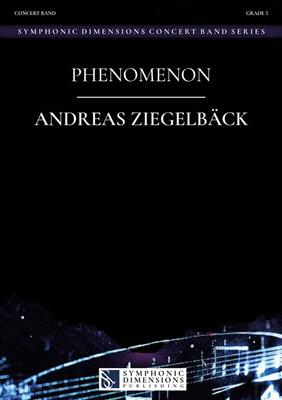 £159.99
£159.99Phenomenon - Andreas Ziegelbäck
Phenomenon" is a captivating piece for symphonic wind orchestra, fundamentally based on a single melodic motif while drawing inspiration from various musical genres. The motif, introduced as a horn solo at the beginning, features alternating intervals that leap both upward and downward: the perfect fourth, sixth, fifth, and second (4-6-5-2). Interestingly, this sequence of numbers corresponds to the postal code of the Austrian town of Steinerkirchen. Phenomenon" is a motivic and musical composition that captures the spirit, emotional intensity, and musicality of the remarkable phenomenon that is the music association of this town.Commissioned by the Musikverein Steinerkirchen" for the regional competition in 2022 at performance level E, this piece is dedicated to them. The music association is directed by Roland Kastner, with organizational leadership provided by Michael and Hubert Ecklbauer. Special thanks are due to these dedicated individuals, who play a significant role in promoting the remarkable phenomenon that is the Musikverein Steinerkirchen". The orchestra consists of a diverse mix of young and older amateurs, all of whom consistently achieve musical excellence through determination and ambition. Each member of this orchestra is, therefore, an integral part of this impressive phenomenon.
Estimated dispatch 7-14 working days
-
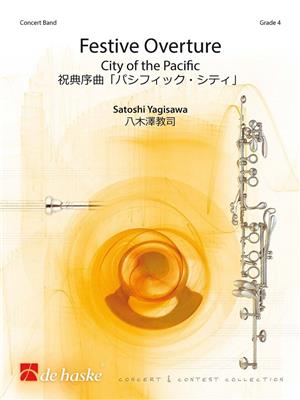 £104.99
£104.99Festive Overture - Satoshi Yagisawa
This work was commissioned by the civilian wind orchestra Shimizu il compagno, based in Shimizu City, Shizuoka Prefecture, Japan, as a commemorative work for their 10th Anniversary. The world premiere was performed by the ensemble, conducted by Hiromichi Hamada in 2017. Having held discussions with the head of the orchestra, Tomohiro Tsuji, and members of the group, Satoshi Yagisawa settled on a central motif for this commemorative work: fellow, or companion, in the sense of the Italian il compagno, which features in the orchestra's name. The work also strives to describe the characteristic friendliness of Shimizu city, a place known for itswarmth and kindness which is visible from both Mount Fuji and the sea. The composition is written in Yagisawa's typical dramatic style with an atmosphere of scintillating light and lyrical warmth, making it an excellent choice for opening a concert.
Estimated dispatch 7-14 working days
-
 £104.99
£104.99Sketches for Flute - André Waignein
This solo work for flute and wind orchestra takes the form of musical sketches that deal with specific aspects of the flute within the orchestra, such as tone, technique, range and character. Beginning with soft tones, in due course the piece buildsaround a virtuoso motif. The orchestra also continually plays an important role by providing a harmonically and rhythmically balanced accompaniment.
Estimated dispatch 7-14 working days
-
£109.99
Dublimania - Menno Bosgra
This new work is based on Irish folk music.In the first part, the main theme is presented as a ballad, starting with the piccolo (as replacement for the flute which is widely used in Ireland), moving on the wood section to end with the entire orchestra.It then changes to a kind of rock style theme: powerful, rhythmic accompaniment with effects in dampers, a pedal point and the use of the spoons which is typical of Irish music (Irish pub), high-range bongo drum (replacement for the Bodhran), etc.In this second part I introduced a second theme as a counterbalance, played by several groups, which has clearly a more legato character and therefore sounds more melodious.The climaxof the work starts in the low-range brass section with its marcato theme that is developed with a great deal of rhythmicity in the accompaniment, clusters, etc. into a percussion solo interspersed by the orchestra in five-eight time with frequent parallel movement in chords (folk music style).Towards the end, theme 2 recurs twice: first as heard earlier with an extra counter melody and accompaniment pattern, then in a canonical form, in which the theme is played by three groups. The conclusion is a repeat of the middle section in five-eight time.I have tried to use many of the colours of a wind orchestra by having the wood sections and brass section play alone and making extensive use of dampers. Percussion also has a prominent role throughout the work.
Estimated dispatch 7-14 working days
-
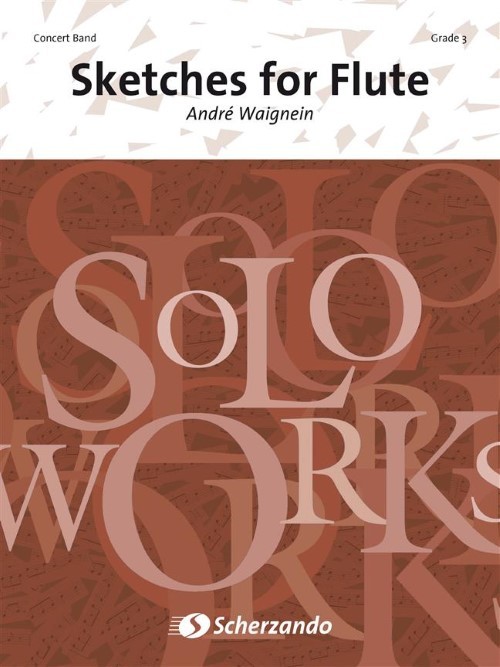 £104.99
£104.99Sketches for Flute (Flute Solo with Concert Band - Score and Parts) - Waignein, Andre
This solo work for flute and wind orchestra takes the form of musical sketches that deal with specific aspects of the flute within the orchestra, such as tone, technique, range and character. Beginning with soft tones, in due course the piece builds around a virtuoso motif. The orchestra also continually plays an important role by providing a harmonically and rhythmically balanced accompaniment.Duration: 7.00
Estimated dispatch 7-14 working days
